william mallindine + elizabeth emma scammell
William was born on 13 March 1857 and baptised at St Matthew on 5 April; he was the eldest son of William Mallindine, a French Polisher, and Elizabeth Mary Pearce. He was born at 5 Hope Street in Spitalfields which lay at the northern end of Wilkes Street between the Great Eastern Railway Line and Truman’s Brewery. Several years later, his family moved to Dorset Street, opposite Christ Church in Spitalfields, before moving to the eastern edge of Bethnal Green to Felix Street and finally back to the neighbourhood near Hope Street. When he was fourteen, he was working for a Printer but he later followed his father into the carpentry trade and worked as French Polisher and cabinet maker.
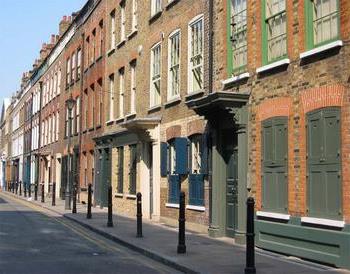
William was living at 3 Orange Street and working as a French Polisher when he married Elizabeth Emma Scammell at St Matthew, Bethnal Green on 27 August 1876. His father signed the register, with his mark, as one of the witnesses along with Elizabeth’s sister Eliza Ann while William was able to sign the register but Elizabeth could only make her mark.
Elizabeth was born on 4 July 1854 to Henry Scammell, a Cellarman, and Elizabeth Sarah Wells and baptised at St Botolph Bishopsgate on 4 August. Her father died when she was thirteen years old and her mother raised her and her three siblings by working as a Shoe Binder.
Their daughter Elizabeth Martha was born on 12 February 1877, six months after their wedding, at 22 Steward Street in Spitalfields and baptised one month later at St Leonard in Shoreditch. Emily Clara was baptised at St Saviour in Pancras on 8 September 1878. Known as Fitzroy Chapel until 1863, the church was located on Maple Street near Fitzroy Square in the civil parish of St Pancras but was destroyed in air-raids in 1945.
Eliza Mary Ann was born in 1880 in the parish of St George in the East but no baptism record has yet been found. Around this time, William left England and set out for New Zealand. No passenger lists have been found but it appears that he left first with the intention of establishing himself before sending for his family. By the 1880s, passenger ships to Australia and New Zealand were larger and faster although the journey still took 45 days with ships following the Atlantic route to Cape Town and then east along the 39th parallel where the westerly winds, known as the roaring forties, carried the ships along at a great speed.
For steerage passengers, the voyage was not a comfortable one with the living quarters limited to tiers of cramped bunks and tables occupying the only available free space. The quarters were divided between single males, married couples, and single females and although the shipping company provided mattresses, they seldom provided bedding. Live animals provided a source of fresh meat and milk for the cabin passengers but those in steerage survived on a monotonous diet of salted and preserved meat, ship’s biscuit, oatmeal and dried potatoes.
In 1881, Elizabeth and her two youngest daughters were living at 7 New Church Street along with her sister Eliza and both of them were working as Dress Makers. Her eldest daughter, 4 year old Elizabeth Martha, was living with her grandmother Elizabeth and her second husband James Atkins on Spicer Street.
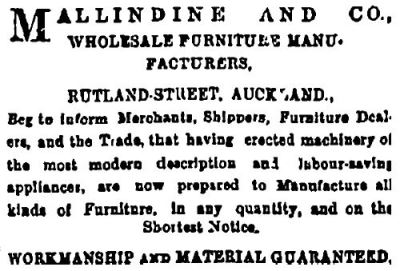
13 January 1885
William settled in Auckland and found a job managing a cabinet making shop on Hobson Street for the Auckland Timber Company and once he was earning a regular wage, he sent for Elizabeth and thier three daughters. They sailed from London on board the Brahmin and arrived in Auckland on 1 March 1883. The family remained in Auckland where Elizabeth gave birth to their first son, William Henry, on 19 December 1884 but the following year, their eldest daughter Elizabeth died aged just 8 years. They lost a second child when Walter George, born in 1885, died before his first birthday.
William had started his own furniture making business called Mallindine & Co. but by the end of 1885, the company was taken over by John Brown and renamed the Auckland Furniture Company but selling the business did not solve William’s financial problems and he was forced to declare bankruptcy on 14 October 1886.
The family left Auckland soon after and moved south to Ngaruawahia a small town 12 miles north-west of Hamliton in the Waikato district. The town was renamed Queenstown and then Newcastle before reverting to its original Maori name. In several Electoral Rolls and newspaper references, William is listed as a ‘village settler’ in Newcastle North and by early March 1887, he and another settler had erected cottages on their land and several more were under construction but it’s not clear if William received a land grant or if he was able to purchase the land outright.
While in Ngaruawhia, they had three more children: Violet Amelia was born on 2 March 1887, Lily Camelia on 27 February 1889 and their eighth and final child, Walter Ernest, on 23 January 1891. William continued to work as a cabinet maker and he was commissioned to complete a new shop interior for watchmaker H.H. Howden in his newly constructed building on Victoria Street in Hamilton. The Waikato Times reported on the opening on 13 August 1892 and highlighted William’s work:
A notice of the buildings would be incomplete without special reference to the internal fittings and decorations of Mr Howden’s own shop, which will be far and away superior to anything in this district, and we think we may safely say would be hard to rival even in Auckland. The whole of this work has been executed by Mr Mallindine of Ngaruawahia and he is certainly a master of his art, some of the best work in Auckland, notably that in Messrs Steward Dawson and Co’s establishment being executed by him.
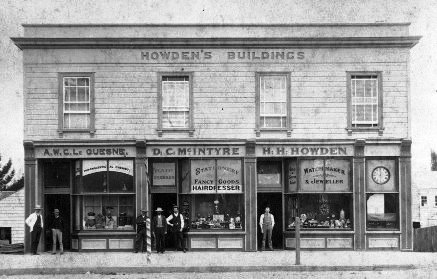
William appeared in the Waikato Times again two years later when they reported that he suffered a broken arm after being thrown from his horse. He had been doing some work at the home of a Dr. Kenny and was returning to Hamilton when the accident occured but luckily, the doctor was able to take him to the hospital and treat his injuries.
Elizabeth appears in a number of government records beginning in 1893 at Te Akatea near Ngaruawahia and two years later at Poverty Farm where she was listed as having 14 sheep but it isn’t known if these refer to the same residence. William also appears in Electoral Rolls up until 1900 at Ngaruawahia with his occupation listed as Gilder and Carver. The family was active in community events with daughters Eliza and Emily participating in the Ngarurwahia Rowing Club’s first exhibition of rowing by young ladies in 1898 with Eliza and her partner winning the final heat.
It appears that Elizabeth lost contact with her family in England as her sister Eliza published a notice in Lloyd’s Weekly newspaper’s ‘Inquiries of Missing Friends’ column asking about the whereabouts of her sister who was known to be in New Zealand in 1894. The Hawera & Normanby Star reprinted the notice on 20 November 1900 but it is not known if Elizabeth saw it or ever made contact with her sister again.
Their eldest surviving daughter Emily was the first to marry to James Christopher Williams in Ngaruawahia on 5 May 1900 and they had one son, Leonard James Lucas, born in Auckland on 27 October 1906. The family celebrated two more weddings in two years beginning with Violet’s marriage to Ernest Reginald Searle in 1908 and then William’s marriage to Emma Cecilia Hoskin on 10 February 1909. Soon after, the Mallindines left Ngaruawahia and settled in a house on Bank Street in the town of Whangerai, 160kms north of Auckland.
Violet and Reginald moved to Auckland and they went on to have five children. Ernest was born in Southwark and when he emigrated to Auckland in 1906, he listed his occupation as a Farmer but when he appears in the 1916-17 WWI Reserve Rolls, he was working as a Commercial Traveller and living on Hamana Street in Narrow Neck Devonport, a neighbourhood in Auckland. Reginald died on 15 November 1960 and was buried in the Papatoetoe Cemetery in Auckland; Violet died on 3 April 1968 in Papakura, Auckland and was also buried at Papatoetoe.
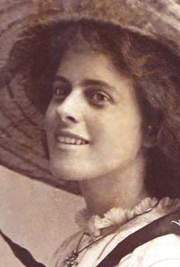
On 14 February 1912, Lily married Charles Reginald Ernest Mackesy at her family home at 114 Bank Street in Whangerai and they had two children, Sybil Jessie and Richard Charles Henry. Charles was born in Clifton, Kansas in 1884 to Charles Ernest Randolph Mackesy and Jessie Adam. His father was born in Ireland but emigrated first to America where he married and then to New Zealand in the 1890s to rescue his father’s lands near Whangerai from being forfeited.
Charles and his two brothers, Harry and William served in the Auckland Mounted Rifles with their father at Gallipoli and later in the desert campaigns. Harry was killed at Gallipoli in August 1915 and Charles was severely wounded after being shot in the chest and arm and was sent to Cairo for medical treatment and then home to New Zealand to recuperate. He returned to the front once more but was invalided home because of his injuries and sailed back to New Zealand on the same transport as his brother-in-law, William.
After the war, Lily and Charles moved to a farm in Whitford, south-east of Auckland, where they raised livestock, including 20 milking cows, and crops. Charles died in Whitford on 20 January 1938 as a result of ‘war wounds, rheumatic fever, and acute syncope’. When his son Richard enlisted in the army several years later, Lily was in Oakland, California visiting her sister Emily but she returned to New Zealand where she died on 22 April 1973; she was buried with her husband at All Saints Cemetery in Howick.
Eliza married Francis Charles Drake at Christ Church in Whangerei on 2 January 1913 and their wedding was announced in the Northern Advocate newspaper the next day:
At Christ Church (Church of England) yesterday morning, Miss E. Mallendine and Mr Francis Charles Drake were married by the Rev. G.C. Cruickshank. Miss E. Drake attended the bride as bridesmaid, and Mr. F. Mogford acted as best man.
Little is known of Eliza and Francis but it does not appear they had any children; they both died in 1946.
On 27 December 1916, Walter married Margaret Sanders at St Luke’s Church in Remuera, a suburb of Auckland, and they had two children, June Winnifred and Mervyn Walter.
William and Elizabeth celebrated their diamond wedding anniversary at their home on Bank Street in Whangerai on 27 August 1936. The newspaper account of the event notes that they arrived in New Zealand 54 years before, about 1882, and lived first at Grafton near Auckland, then Ngaruawahia and finally Whangerai. Two years later, the local newspaper reported that ‘Dr. E. Williams, eldest daughter of Mr and Mrs Mallendine, is on a visit from California, and is the guest of her sister, Mrs F. Drake, First Avenue’ and she also paid a visit to her brother Walter in Tauranga. Emily had divorced her husband, James Williams, in Wellington in 1920 and seven years later, she left New Zealand and settled in the town of Hayward near Oakland, California. In 1934, she applied for naturalization and listed her occupation as a trained nurse but there is no indication of how she came by the title of ‘doctor’. Strangely, she declared on her naturalization application that she had no children and made no mention of her twenty-eight year old son Leonard.
In 1930, Emily was living at 595 Chestnut Street in Hayward, along with one lodger, and was working as a trained nurse on private duty. In the 1940s, she married a second time to widower Peter Joseph Freitas. Emily died at the Memorial Hospital in Gridley, California on 12 August 1959 and her obituary was published in the local newspaper:
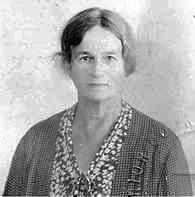
Emily Clara Freitas, 82, of Gridley died Saturday at the Memorial Hospital at Gridley after an illness of six weeks. A native of New Zealand, she had lived in the Gridley area since 1948. She was a nurse and during World War I served with the U.S. Army Nursing Corps. She is survived by her husband, Peter; two sons, Raymond of Hayward and Len Williams of New Zealand; a daughter, Mrs. Alice Fratus of Oroville; two sisters, both of New Zealand and by five grandchildren. Funeral services are scheduled tomorrow at 2 p.m. at the Gridley Funeral Chapel with Rev. Paul Smith of the Gridley First Baptist Church officiating. Interment will be in the Gridley-Biggs Cemetery.
William died on 14 December 1943, aged 86 years, and was buried at Maunu Cemetery two days later; his obituary states he was survived by his wife, a grown up family, nine grandchildren and eight great-grandchildren. Elizabeth died on 25 August 1944 at her home on Bank Street was buried the next day at Maunu Cemetery. Her obituary notes that daughter Emily was living in California, Violet in Papakura, William in Whangerei, Walter in Tauranga on the Bay of Plenty.